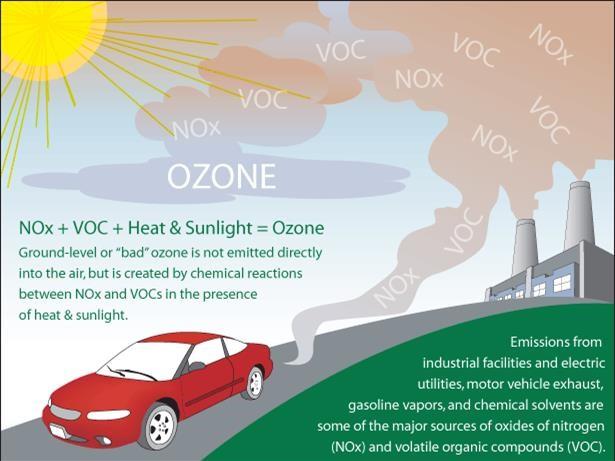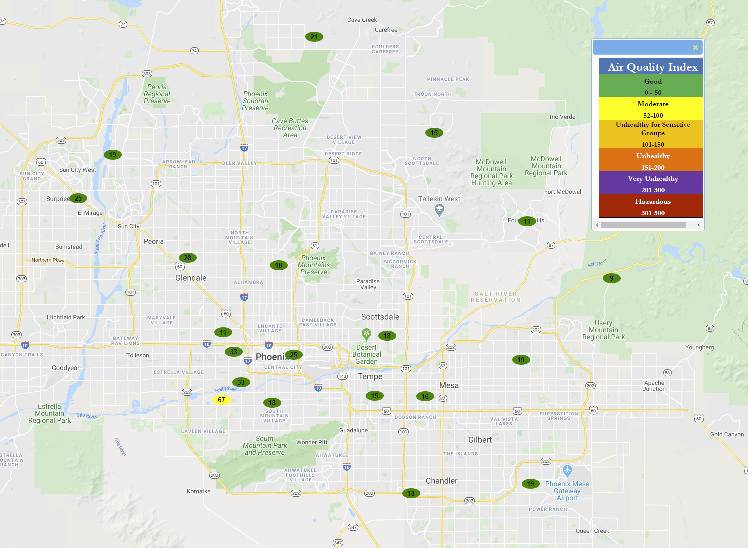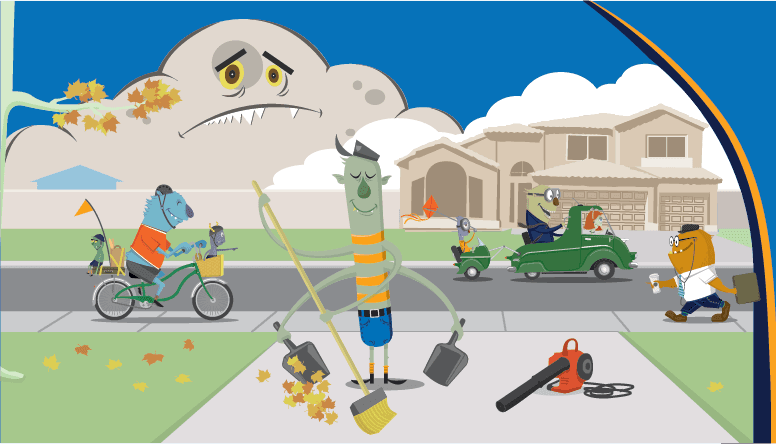Phoenix launches a Citywide food drive to assist residents experiencing food insecurity during the holidays.
Ozone

Ozone is a colorless gas composed of three atoms of oxygen. Ozone occurs both in the Earth's upper atmosphere (good ozone) and at ground level (bad ozone). Ozone can be good or bad for human health and the environment, depending on where it is found:
Ozone occurs naturally in the Earth's upper atmosphere where it forms a protective layer that shields us from the sun's harmful ultraviolet rays. Some manmade chemicals are known to destroy this beneficial ozone and can cause depletion of upper atmosphere ozone causing ozone holes to form.
At the ground level, ozone is not emitted directly into the air but is created by chemical reactions that occur when oxides of nitrogen (NOx) and volatile organic compounds (VOC) come into contact in the presence of sunlight (ultraviolent light) . Unhealthily levels of ozone form at the ground level in Phoenix because we have an abundance of warm, sunny days. Ozone at ground level is a harmful air pollutant. Learn more about Ozone and related health concerns from EPA

What is being done in Phoenix?
In 2024, The City of Phoenix alone reduced employee commuting miles by participating in the Travel Reduction Program, preventing 95 tons of pollution. For Maricopa County results, click here (PDF).
EPA - DERA Grants
The City of Phoenix completed all requirements for the Diesel Emissions Reduction Act (DERA) grant received from EPA in 2017 and successfully closed the grant in 2020. The grant provided $692,252 to replace 17 model year 1995-2006 heavy-duty vehicles and retrofit vehicle exhausts in 10 fire pumpers. The vehicles selected for the grant have a daily presence in Phoenix residential neighborhoods.
Over the remaining lifetime of the 27 vehicle engines, these upgrades are estimated to reduce emissions of fine particulate matter (PM2.5) by 0.5 tons, nitrogen oxides (NOx) by 9.2 tons, hydrocarbons by 0.7 tons, carbon monoxide by 2.6 tons, and carbon dioxide by 72 tons. The project is also expected to conserve over 6,400 gallons of diesel fuel using more fuel-efficient technology.
In 2019, Phoenix received a DERA grant that will help replace 10 Class 8 diesel refuse trucks with year 2019 or newer Class 8 trucks powered by compressed natural gas. Learn more (PDF)
In 2020, Phoenix received a DERA grant to replace 9 Class 8 diesel refuse tracks with newer model year trucks powered by compressed nature gas. Learn more (PDF)
What you can do to reduce ozone:
- Use alternative modes of transportation like walking, riding a bike, car or vanpool, or using public transportation.
- Don't idel your car and avoid waiting in long drive-thru lines, for example, at coffee shops, fast-food restaurants or banks. Park your car and go inside.
- Re-fuel your vehicle after dark (or during cooler, evening hours).
- Replace old lawn equipment with electric equipment

Maricopa County Air Quality Monitors
The Maricopa County Air Quality Department monitors air quality using a collection of monitors around the valley. There are 4 monitors in the City of Phoenix that measure the concentrations of Ozone, PM 10, and PM 2.5.

Maricopa County Air Quality Programs and Campaigns
-

Mowing Down Pollution Program
This program provides residents vouchers towards the cost to replace gasoline powered equipment for new electric or battery powered equipment.
-

Help Keep Ozone Away, Commit to One Day!
Small actions add up! Make one behavior change each day to help do your part to reduce ozone pollution!
-

Care for Clean Air, Be Idle-Free!
Idling for more than 10 secs uses produces more emissions than stopping and restarting your engine. Reduce idling time to help improve air quality!